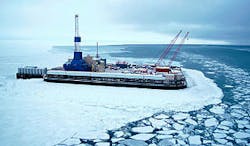Alaska Update: New era dawning for Alaskan North Slope
The articles in this special report were written by Executive Editor Bob Williams. Late-breaking adjuncts to the special report also lead off the General Interest and Exploration and Development sections in this issue.
A new era has dawned for Alaska's oil and gas industry.
A few years ago, some might have said a more apt description was that a twilight gloom was gathering.
However, the administration of Presi dent George W. Bush has placed the largest US state at the very center of his controversial new energy policy plan. Both the effort to deliver Alaskan natural gas to the Lower 48 and the polarized debate over opening the Arctic National Wildlife Refuge coastal plain to drilling are key elements of that policy. Both issues have drawn a great deal of attention in public forums across the US, in Washington, DC, and in Alaska itself.
What hasn't received as much attention is the revival of oil and gas industry interest in Alaska's vast potential to yield still more hydrocarbons, especially on the North Slope.
The oil and gas industry would be well-served by a broader recognition that this rejuvenation of the North Slope as a petroleum province needs to be considered in the context of ANWR and ANS gas debates. That's because it reflects what the North Slope oil and gas industry is capable of doing, given the right incentives.
What the North Slope industry is capable of accomplishing is:
- Operating in the harshest of physical conditions while setting the highest standards of environmental protection in the industry.
- Introducing new technology and tweaking available technology until it squeezes the last cent of cost-savings or the last work-hour of efficiency out of an otherwise marginal project.
- Using the latest technology to reconstruct the subsurface and then rethink the accepted concepts about where to find oil and gas.
None of these efforts are new or exclusive to the slope. All are essential to industry operations everywhere today, as pressure mounts on corporate bottom lines and competition accelerates.
What makes a difference, however, is that the North Slope industry is capable of accomplishing all these things in what is arguably the most difficult and costly operating conditions on earth, in a region widely perceived as a national treasure.
A new era
Dramatic change has swept across Alaska's petroleum industry in recent years.
A long-admired North Slope operator, ARCO, has vanished into the bowels of another company. That acquiring company, BP PLC, now is sole operator of North America's largest oil field, ending decades of split operatorship at Prudhoe Bay. A new North Slope major operator, Phillips Petroleum Co., has already made its mark with an impressive beginning in exploration and development.
New independent players, such as Houston's Anadarko Petroleum Corp. and Calgary's Alberta Energy Co., have established themselves in a theater long believed to be the exclusive playground of just the major oil companies.
Much as in the North Sea, declining giant and supergiant oil fields on the slope are evolving into hubs for a myriad of small satellite developments in the shadow of existing infrastructure.
At the same time, step-changes in drilling and production technology are being nudged along ruthlessly to the point where they represent new evolutionary strides in how a reservoir should be exploited and managed. These strides are padding the margin for the economic threshold of major projects as well as satellites.
This, in turn, is changing the outlook for Alaskan oil production. Despite declining oil output in recent years, the state is now projecting a modest increase in fiscal 2002-to 1.069 million b/d, vs. 995,500 b/d this fiscal year and 1.035 million b/d in fiscal 2000.
Not long ago, Alaskan industry grappled with how to stave off the inevitable: when oil output would fall to the turndown point for the Trans-Alaska Pipeline System. Now, a note of confidence is creeping into the discussion about TAPS being viable many years into the future.
And the prospect of another pipeline from the slope has spawned talk of a new generation of exploration, development, and production there: North Slope natural gas, long just the stuff of distant promise and current reservoir maintenance, is now a viable candidate for exploration.
Perhaps most important, the North Slope has become a showcase for the oil industry operating with care, wherever the pendulum has swung on the always contentious debate on energy-environment tradeoffs.
Just as the promise and potential of ANWR and North Slope gas can leverage industry's level of activity on the slope, so too, can recognition of this new era of operations on the slope can help leverage the debate about those two crucial pieces of the US energy puzzle.
And thus a mature province is reborn.



